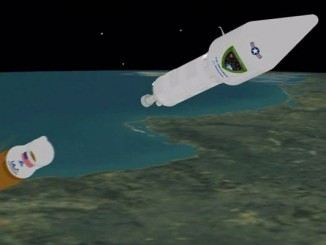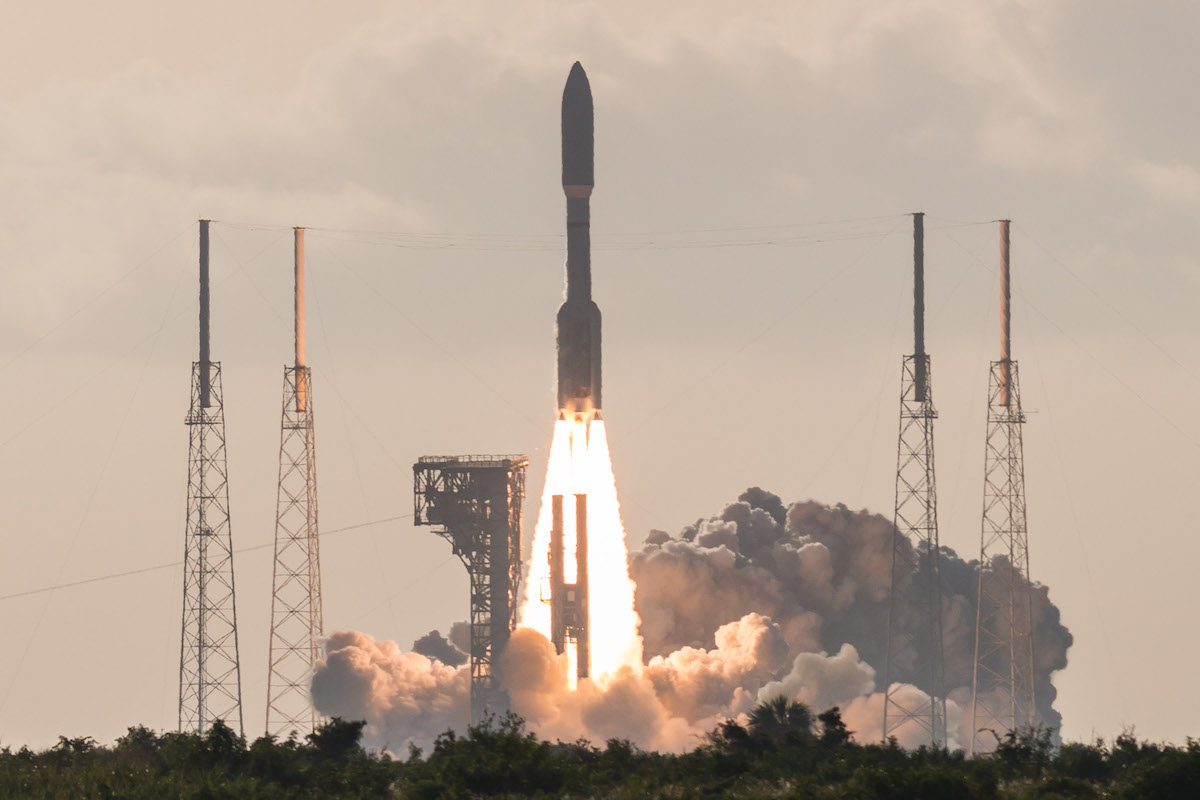
Persevering through a global pandemic, a last-minute earthquake, and the trials of a rocket launch, NASA’s next Mars rover — named Perseverance — took off from Cape Canaveral Thursday on a nearly seven-month journey to the Red Planet with sophisticated science instruments, technology to collect samples for to Earth, and the first interplanetary helicopter that could produce a “Wright Brothers moment” on another world.
The $2.7 billion Mars 2020 billion mission is poised to achieve numerous firsts on the Red Planet, but first it had to leave Earth on top of a powerful rocket to kick off a 300-million-mile (nearly 500-million-kilometer) voyage through the solar system.
An Atlas 5 rocket built by United Launch Alliance — a 50-50 joint venture between Boeing and Lockheed Martin — gave the Perseverance rover a perfect ride into space Thursday after lifting off from Cape Canaveral at 7:50 a.m. EDT (1150 GMT).
Four solid rocket motors and a Russian-made RD-180 main engine gave the Atlas 5 and the Perseverance rover their initial boost into space. An RL10 engine on the Centaur upper stage, fueled by an efficient mix of liquid hydrogen and liquid oxygen propellants, fired two times to accelerate the Mars-bound rover to a velocity of nearly 25,000 mph (more than 11 kilometers per second).
That was enough speed to allow the 9,000-pound (4.1-metric ton) spacecraft to break free of the grip of Earth’s gravity and head into deep space.
The Perseverance rover is the centerpiece of NASA’s Mars 2020 mission, which will seek signs of ancient microbial life forms that scientists believe could have populated the Red Planet billions of years ago.
The six-wheeled rover is essentially a robotic geologist, but it also hosts trailblazing technologies that will pave the way for future missions. Those include NASA’s Mars Helicopter, named Ingenuity, and an experiment to demonstrate the production of oxygen from carbon dioxide in the Martian atmosphere.
“We’re doing transformative science,” said Matt Wallace, the Mars 2020 mission’s deputy project manager at JPL, before the mission’s launch. “Really, for the first time, we’re looking for signs of life on another planet, and for the first time we’re going to collect samples that we hope will be part of the first sample return from another planet.”
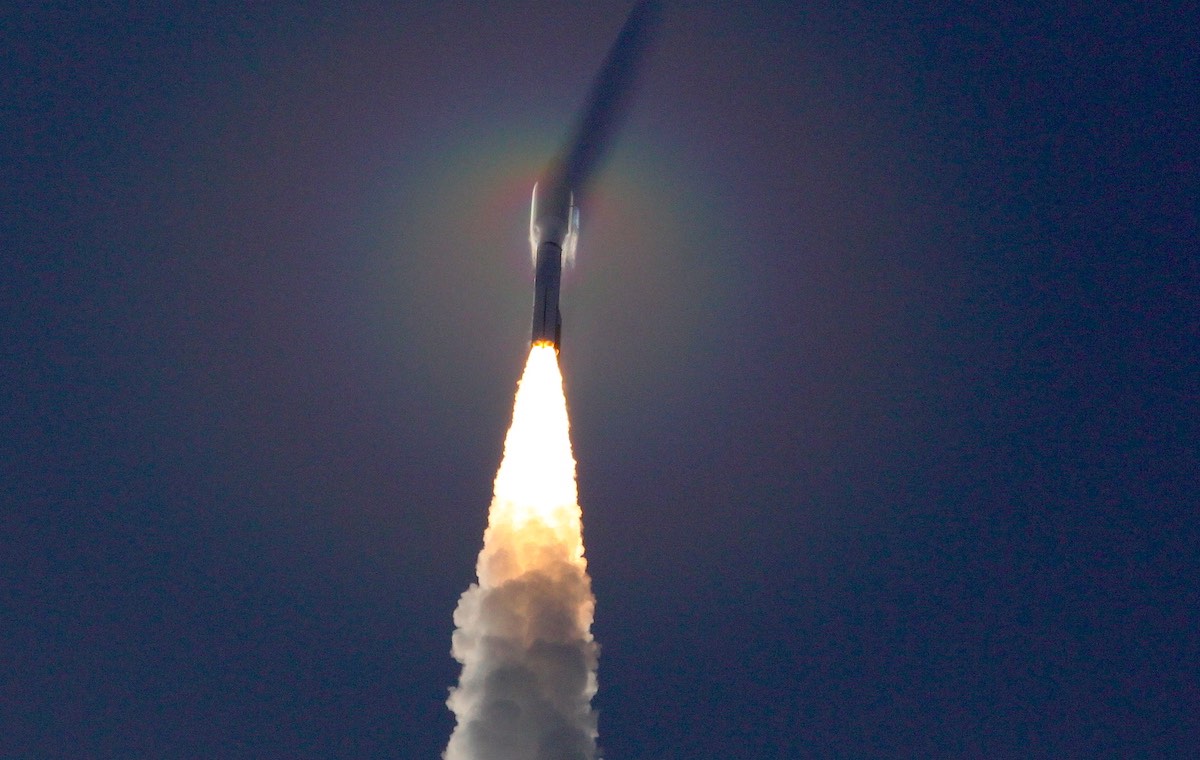
The Atlas 5 launcher performed flawlessly Thursday, deploying the Mars 2020 spacecraft right on its predicted course nearly one hour after liftoff. The Centaur upper stage spun up to about 2 rpm before releasing the spacecraft.
The rocket injected the probe into an orbit between the planets around the sun, setting the stage for a cruise to Mars that will culminate in a high-stakes, one-shot attempt to land on Red Planet on Feb. 18, 2021.
“The orbital parameters look dead on,” said Omar Baez, NASA’s launch director for the Mars 2020 mission. “Our velocity is dead on. So we’re on our way to Mars. There’s no way back.”
While the Perseverance rover itself won’t come back from Mars, some of the hardware on-board the vehicle is designed to eventually return to Earth. The rover carries 43 tubes, each about the size of a slim cigar, to hold rock and soil samples collected after Perseverance’s landing. The vehicle will drop the tubes on the surface of Mars for retrieval by another robotic mission in the late 2020s, which will bring the specimens back to Earth.
“The mission objectives of our effort are to explore the geology of our landing site, to look for signs of biosignatures from the past,” said Adam Steltzner, chief engineer on the Mars 2020 mission at NASA’s Jet Propulsion Laboratory. “We are not a life detection mission. We are looking for signs of past life on the surface of Mars. Also, signatures that Mars was habitable, and to the degree that is still habitable, where it might be habitable. Our third objective is to prepare a returnable cache of samples, and then fourth is to prepare for future human exploration.”
While the launch itself was as advertised, ground controllers at JPL initially had trouble establishing a two-way communications link with the Mars 2020 spacecraft after it separated from the Atlas 5 rocket. Right on time, at 9:15 a.m. EDT (1315 GMT), the spacecraft turned on its transmitter and began sending a carrier signal to a NASA ground station in Australia.
But the Deep Space Network station is usually attuned to listening for faint signals from distant regions of the solar system. The high-power signal coming from the Mars 2020 spacecraft saturated the antenna’s receiver, so operators had to adjust settings at the ground station to begin deciphering telemetry information the probe was sending back to Earth shortly after launch Thursday.
Here’s a replay of the liftoff of the Atlas 5 rocket with NASA’s Perseverance rover. Continuing live coverage: https://t.co/B6rcMHiZuY pic.twitter.com/COSlGjCU3C
— Spaceflight Now (@SpaceflightNow) July 30, 2020
A couple of hours later, NASA officials confirmed they were receiving telemetry data from Mars 2020. Soon after, Wallace said the mission had encountered a separate issue after launch that put the spacecraft into safe mode, a precautionary standby state where the probe’s computer curtails non-essential functions.
In an interview Thursday afternoon, Wallace said the spacecraft apparently went into safe mode as it passed over the night side of Earth just after launch, a period known as an eclipse.
“We think that as we went through eclipse, where the spacecraft is shadowed by the Earth from the sun, the external temperatures changed,” Wallace told Spaceflight Now.
NASA later said in a statement that the temperature disparity was in the Mars 2020 spacecraft’s liquid freon coolant loop, which dissipates heat from the center of the spacecraft through radiators on the carrier module carrying the rover to Mars.
Temperatures outside the spacecraft may have dipped lower than expected, he said, creating a higher-than-expected temperature differential between the warm radiator inlet and the cooler outlet. As a precaution, programmers set tight limits on key spacecraft parameters before the launch, and the cold conditions may be tripped a preset limit.
“Chances are we may have just tightened down on that limit a little too much, and it triggered a safe mode,” Wallace told Spaceflight Now.
NASA’s Curiosity rover, upon which Perseverance was designed, did not enter the Earth’s shadow after its launch in 2011. So engineers relied on analytical modeling to predict the temperatures during the eclipse.
“We set the limits for the temperature differential conservatively tight for triggering a safe mode,” Wallace said. “The philosophy is that it is far better to trigger a safe mode event when not required, than miss one that is. Safe mode is a stable and acceptable mode for the spacecraft, and triggering safe mode during this transitional phase is not problematic for Mars 2020.”
While it’s in safe mode, the spacecraft transmits data back to Earth at a slower rate than during normal operations. Ground teams Thursday afternoon were trying to increase the data rate, but the information coming down from the Mars 2020 spacecraft thus far indicated there were no other problems on the probe, and temperatures were back within limits after the craft flew back into sunlight.
“We are getting good telemetry,” Wallace said. “It’s indicating the spacecraft is healthy.”
#MarsPerseverance on its way to the Red Planet… pic.twitter.com/8XeEehuml8
— Tory Bruno (@torybruno) July 30, 2020
Controllers at JPL will complete their assessment of the spacecraft’s condition, develop and test commands, then uplink the orders to the Mars 2020 spacecraft to bring it back into its normal operating mode, perhaps as soon as Friday, according to Wallace.
“We’re in no hurry,” he said. “We’re perfectly happy in safe mode.”
One of the first major milestones on the flight to Mars will be a course correction maneuver using the Mars 2020 spacecraft’s cruise stage, the element that helps guide the rover during the interplanetary journey to the Red Planet. That burn will adjust the spacecraft’s trajectory to aim directly at Mars after the Atlas 5 rocket intentionally put the probe on path that would just miss Mars, ensuring the launcher’s Centaur upper stage will not crash into the planet.
Wallace said it is not unusual for a newly-launch spacecraft to go into safe mode.
“Basically, the spacecraft is transitioning out of one environment into another,” Wallace said. “So it’s not uncommon for something to trigger it. Safe mode is called safe mode because it’s the safest condition for the spacecraft to be in.”
But there was a brief bit of drama before the launch. A small earthquake in Southern California gave a jolt to Mars 2020 mission control at JPL, near Los Angeles.
After a quick assessment, officials determined the ground controllers, who were following health protocols to protect against the COVID-19 pandemic, were ready to proceed with the launch of the Mars 2020 spacecraft from Cape Canaveral, on the other side of the country.
“The people in California thought they felt an earthquake, but really they were just feeling mighty Atlas crouching down to leap off the Earth,” joked Tory Bruno, ULA’s president and CEO, in a reference to the Atlas 5 rocket.
NASA is going for its ninth successful landing on Mars with the Perseverance rover.
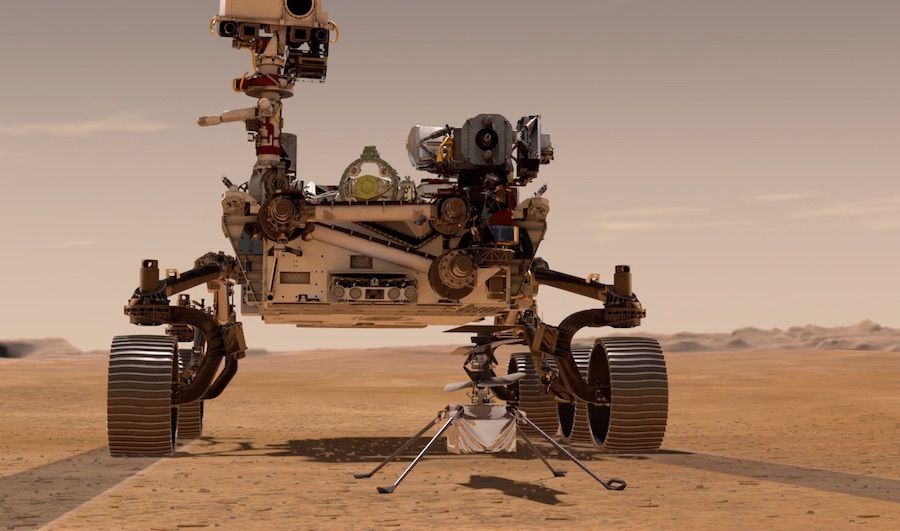
NASA says it spent more than $2.4 billion to design, build and prepare the Mars 2020 mission for launch. With the money budgeted to operate the rover during the trip to Mars, and for around two Earth years (one Mars year) after landing, the total mission is expected to cost around $2.7 billion.
The 2,260-pound (1,025-kilogram) Perseverance rover is about 10 feet (3 meters) long, 9 feet (2.7 meters wide), and 7 feet (2.2 meters) tall.
The rover is mounted on a rocket-powered descent stage that will lower the robot to the Martian surface. That, in turn, is cocooned inside an aerodynamic shell and heat shield to protect the rover during entry into the atmosphere of Mars, when temperatures outside the spacecraft will reach 2,370 degrees Fahrenheit (about 1,300 degrees Celsius).
The cruise stage attached to the Mars descent vehicle will shepherd the spacecraft from Earth to Mars. The carrier module will jettison before arriving at the Red Planet, and will burn up in the Martian atmosphere.
While any space launch has some risk, landing a spacecraft on Mars is a hazardous proposition. About half of all missions that have attempted to land on Mars have failed, although NASA has succeeded five consecutive Mars landing attempts.
NASA’s Perseverance rover is the third mission to Mars to launch this month, following the July 19 takeoff of the Hope orbiter developed by the United Arab Emirates in partnership with scientists at three U.S. universities. On July 23, China launched its Tianwen 1 spacecraft, an all-in-one mission consisting of an orbiter, lander and rover.
The Hope and Tianwen 1 missions are the first probes from the UAE and China to head for Mars.
“We welcome more nations taking trips to mars and studying it and delivering the science and sharing the science with the world,” said Jim Bridenstine, who became head of NASA in 2018 after his nomination by President Donald Trump. “That’s what science is all about, of course, it’s a very uniting kind of thing.”
Bridenstine said he did not see NASA as in a competition with other nations for Mars exploration.
“This is our ninth time to go to Mars and land softly, and do robotic experiments and discovery,” he said. “So I don’t see it as a competition, but certainly we welcome more explorers to deliver more science than ever before, and we look forward to seeing what it is that they’re able to discover.”
Orbiters from the United States, the European Space Agency, and India are currently flying around Mars and observing the planet from above.
All three missions will arrive at the Red Planet next February, with the UAE’s Hope spacecraft and China’s Tianwen 1 spacecraft swinging into orbit around Mars. Several months later, Tianwen 1 will release its lander in a bid to descend to the Martian surface and deploy its rover.
If successful, China would become the second country to land and operate a mobile robot on Mars, after the United States.
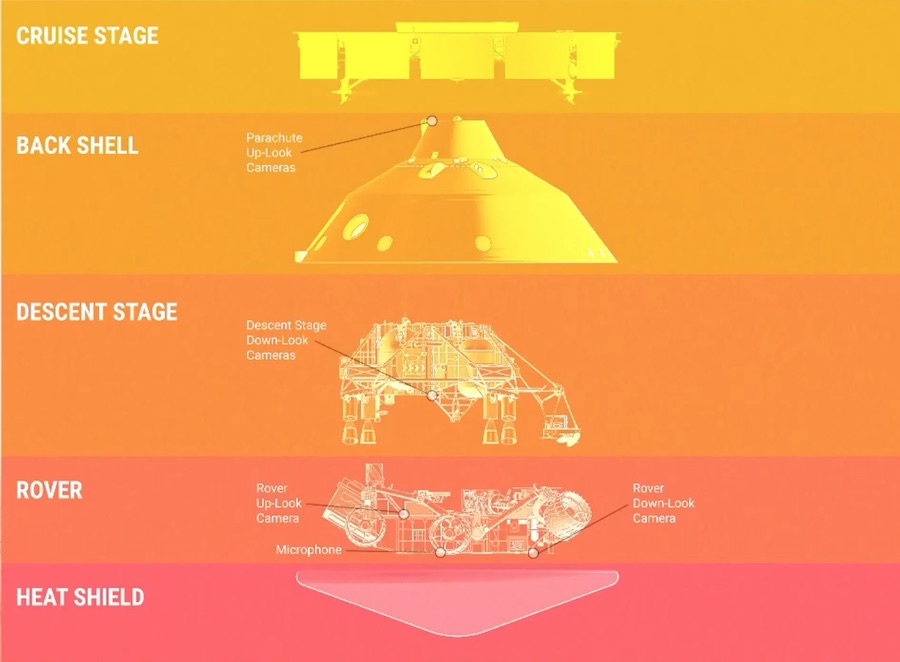
The Perseverance rover will aim for a direct approach to Mars, heading straight into the planet’s rarefied atmosphere next Feb. 18. Around 10 minutes before reaching the upper edge atmosphere, the spacecraft will shed the cruise stage that will have guided the rover toward Mars since its launch.
The rover’s 14.8-foot-diameter (4.5-meter) heat shield will take the brunt of the energy during the craft’s plunge into the atmosphere of Mars. While temperatures outside the heat shield reach more than 2,000 degrees Fahrenheit, small thrusters will adjust the angle of the vehicle’s trajectory, allowing it to control lift and begin navigating toward its landing site.
Around four minutes after entering the atmosphere, the spacecraft will unfurl a 70.5-foot-diameter (21.5-meter) supersonic parachute at an altitude of about 7 miles, or 11 kilometers. Perseverance’s parachute is stronger than the one used on Curiosity, and the Mars 2020 mission will employ a new technique to deploy the chute based on the craft’s position relative to the target landing site, rather than using a timer.
That will result in a more precise landing, NASA says.
Roughly 20 seconds after deploying the parachute, the heat shield at the bottom of the spacecraft will drop away, allowing a downward-facing guidance radar and cameras to start seeing the Martian surface.
The atmosphere of Mars is much thinner than Earth’s, so a parachute by itself is unable to slow the spacecraft enough for a safe landing. The rover’s descent stage will release the backshell and parachute around 1.3 miles (2.1 kilometers) above Mars. Eight throttleable thrusters will further slow the rover’s descent from about 190 mph (306 kilometers per hour) to a speed of near zero just 66 feet (20 meters) above the surface.
During this time, advanced guidance software loaded into the rover’s flight computer will begin searching for a smooth place to set down. The new capability, named terrain relative navigation, was developed since Curiosity’s landing in 2012 and will be used on Mars for the first time with Perseverance.
It works by comparing imagery taken in real-time during descent with a map of steep slopes, boulders and other hazards pre-loaded into the computer using pictures captured from Mars orbiters. If the rover sees it is heading for dangerous terrain, it will adjust its path to reach a smoother area.
Finally, a bridle will lower the one-ton Perseverance rover to the surface of Mars using a technique called the sky crane, which engineers invented and demonstrated on the Curiosity rover’s landing in 2012. Once the rover’s six wheels touch Mars, the bridle will be cut and the descent stage will fly away to crash a safe distance away.
That all happens millions of miles from Earth, when it takes minutes for a radio signal to travel between the planets at the speed of light. That leaves no opportunity for human input once the descent begins.
“It’s basically a controlled disassembly the whole way,” Wallace told Spaceflight Now. “It’s, by far, the highest risk phase of the mission still, and we had the good fortune on Mars 2020 to have leveraged the system that we designed on Curiosity.
“So not only we do have the testing behind us on this system that we did before we launched and landed Curiosity, we have the Curiosity flight itself, and all the telemetry that came back,” he said. “And it performed extremely well during that mission. Then we did a whole lot of additional testing to launch this spacecraft.
“Still, no guarantees,” Wallace said. “Our hearts will still be beating hard when we get to that point in the mission, but I do think it’s an advantage that we have. This is not a first-time landing system as we had on Curiosity.”
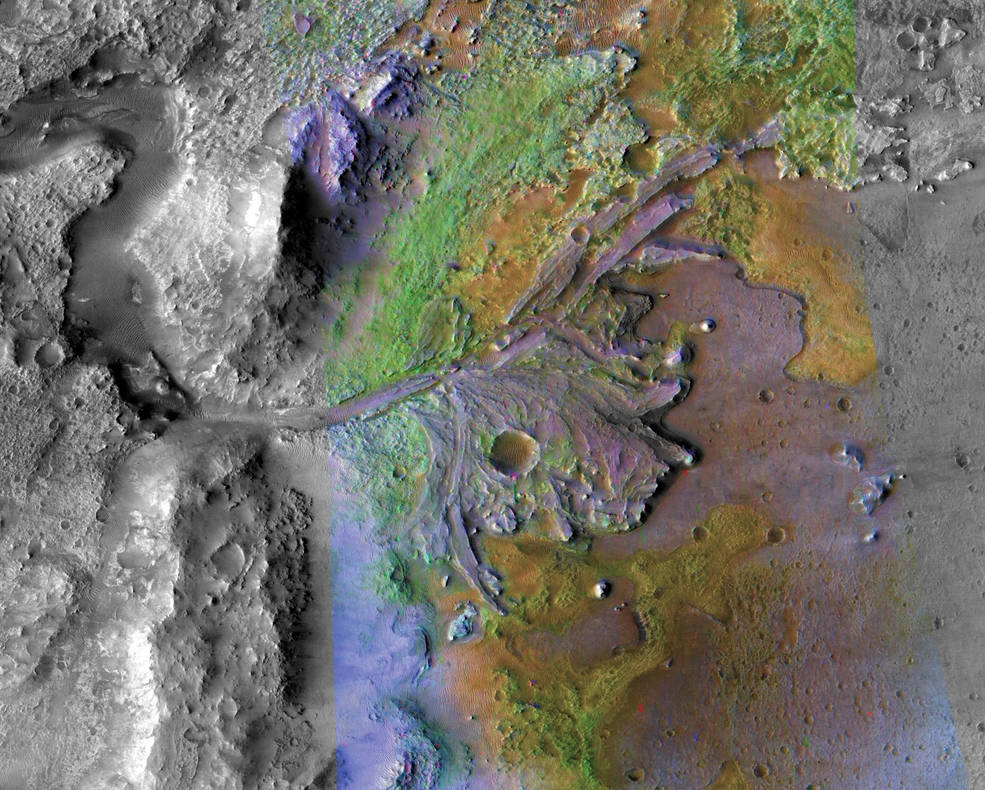
Credits: NASA/JPL-Caltech/MSSS/JHUAPL
The Perseverance rover will target a landing inside the 28-mile-wide (45-kilometer) Jezero Crater on Mars, home to an ancient river delta and a lake the size of Lake Tahoe that scientists believe filled the crater some 3.5 billion to 3.9 billion years ago. Scientists hope to find signatures of ancient life in the rocks and sediments deposited in the dried-up delta.
Perseverance is designed to land as close to the delta deposits as possible.
“To get down onto the crater floor right on top of the delta, we need to do better than we’ve ever done before,” Steltzner said.
Once the rover is on Mars and powers up its science instruments, one of its first tasks will be to place NASA’s Ingenuity Mars Helicopter onto the surface. Perseverance will release the rotorcraft from a carrier on its belly onto the ground, then drive away to a distance of at least 330 feet (100 meters) before the helicopter flies for the first time.
That moment will be historic. The tiny 4-pound (1.8-kilogram) robot will try to become the first aircraft to fly through the atmosphere of another planet.
“Human beings have never flown a rotorcraft outside of our own Earth’s atmosphere, so this will be very much a Wright Brothers moment, except at another planet,” said MiMi Aung, project manager for the Ingenuity helicopter at JPL.
Ground controllers will program the helicopter to perform a series of test flights during a planned 30-day campaign, beginning with a relatively simple up-and-down flight lasting less than 30 seconds, Aung said. Then the team will attempt “bolder and bolder” test flights, she told Spaceflight Now.
The helicopter will fly autonomously, without real-time input from ground controllers millions of miles away. The drone carries two cameras, and telemetry from the helicopter will be routed through a base station on the rover. The Perseverance rover also might be able to take pictures of the helicopter in flight.
“For the first time ever, we’re going to fly a helicopter on another planet,” Bridenstine said. “In the future, it could transform how we do planetary science on other worlds, and eventually it could be a scout so we can figure out where we need to send our robots.”
NASA officials approved adding the helicopter to the Mars 2020 mission in 2018. The mission cost around $80 million to design and develop, and will cost another $5 million to operate.
The atmosphere at the Martian surface is about 1 percent the density of Earth’s, limiting the performance of a rotorcraft like the Ingenuity helicopter.
The helicopter’s counter-rotating rotors will spin between 2,400 and 2,900 rpm, about 10 times faster than a helicopter flying in Earth’s atmosphere. Developed at JPL with assistance from a company named AeroVironment Inc., the Ingenuity rotorcraft is tiny compared to the Perseverance rover. The solar-powered drone measures just 1.6 feet (0.49 meters) tall, weighs about 4 pounds (1.8 kilograms), and has blades spanning about 4 feet (1.2 meters) in diameter.
While the Ingenuity helicopter is purely a technology proof-of-concept, future rotorcraft could be dispatched to other planets with more sophisticated scientific instruments.
NASA has selected a robotic mission named Dragonfly to explore Saturn’s largest moon Titan. But Titan has a much thicker atmosphere than Mars, which eases the difficulty of rotor-driven flight.
Debuting a wide array of new capabilities, the Mars 2020 mission is packed with firsts.
We’re making oxygen on the surface of Mars for the first time,” Wallace said. “For the first time we have an opportunity to use autonomous systems to avoid hazards as we land in Jezero Crater, and that’s technology that will feed forward into future robotic systems and human exploration systems.
“We’re also carrying microphones for the first time,” he said. “We’re going to hear the sounds of the spacecraft landing on another planet and the rover drilling into rocks and rolling over the surface of Mars. That’s pretty exciting.
“For the first time, we’re going to have an opportunity to see our spacecraft land another planet,” Wallace continued. “We’ve got commercial ruggedized cameras that we’ve distributed essentially all over the spacecraft, and they will get high-definition video that we’ll bring back after we land on the surface from the entire landing activity — from the inflation of the parachute to the touchdown of the rover.”
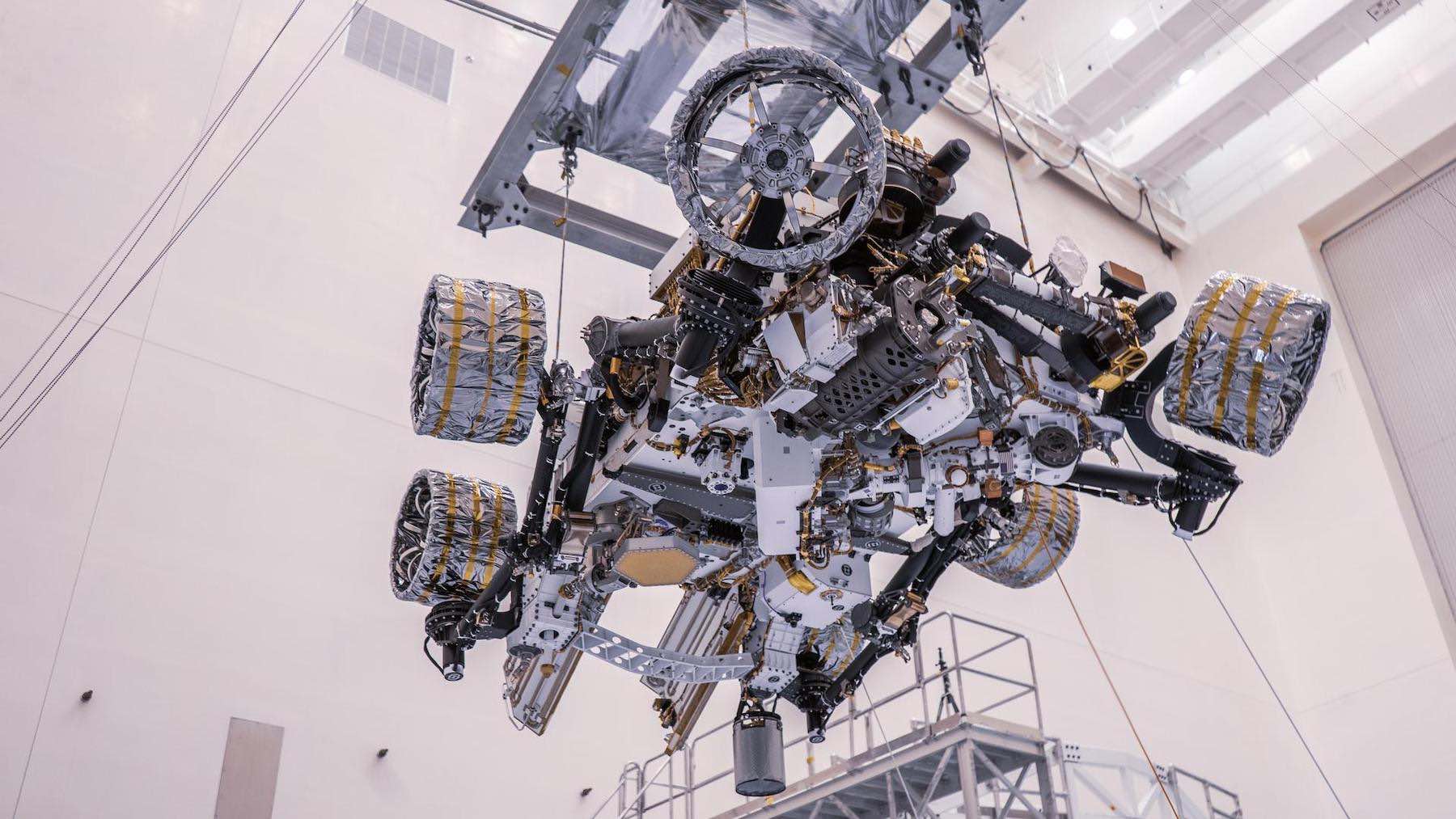
The Mars 2020 mission’s development cost swelled nearly $360 million over NASA’s original prediction, according to the Government Accountability Office. That was caused primarily challenges with perfecting the devices that will collect, seal and store rock specimens, along with difficulties with instruments.
“Along the way, we had plenty of challenges,” Wallace said. “We had to qualify a new planetary parachute. That’s another first — the first time we’ve done that as an agency in 40 or 50 years.
“Kind of late in the game, we were asked to accommodate this little thing called Mars Helicopter,” he said. “It was well after most of the payloads were assigned to the project, so we had to do a little bit of magic trick to get that onto the rover.”
Around the time of Curiosity’s landing on Mars in 2012, engineers at JPL started assessing options for NASA’s next major Mars rover. NASA leadership announced plans for the Mars 2020 mission in late 2012, seeking to recycle designs proven with the Curiosity mission — also known as Mars Science Laboratory — with a different set of scientific instruments, and the new ability to drill core samples, seal them inside ultra-clean tubes, and drop them onto the Red Planet to be picked up years in the future.
“We need to make the sample tubes that we take to Mars cleaner than anything that we’ve ever done before in space, and cleaner than almost everything we do here on Earth,” Steltzner said. “Part of the effort to do that involves us hyper-cleaning the sample tubes in which the samples that we take on Mars will be placed, and then placing them into the rover at last possible minute.”
Read more about the sampling system in our earlier story.
The sample tubes were installed into the Perseverance rover in May, just before it was closed up inside its aeroshell and mounted on top of the Atlas 5 rocket.
Each tube is sheathed in a gold-colored cylindrical enclosure, providing an extra layer of contamination protection. The tubes will ride to Mars inside the housing, and they will be returned to the sheath once filled with Martian rock samples.
The Perseverance rover will carry 43 sample tubes to Mars, including “witness tubes” or blanks, which will allow scientists to cross-check rock and sediment specimens returned to Earth for contamination.
The tubes are about the size and shape of a slim cigar, and the Perseverance rover will collect core samples on Mars that measure around a half-inch (13 millimeters) wide and 2.4 inches (60 millimeters) long.
“Those samples tubes are part of a Sample and Caching System, which is one of our biggest engineering developments for this mission,” Steltzner said. “We get to Mars largely like the Curiosity rover got to Mars, but we need to do something very different once we’re on Mars. We must take these core samples, seal them hermetically and sterilely, and then produce a cache of samples for eventual return to Earth.”
The Sample Caching System is a complicated piece of equipment, with 17 separate motors, a rotating wheel containing nine drill bits, and 43 tubes to hermetically seal core samples drilled from Martian rocks.
The rover has a 7-foot-long (2-meter) robotic arm with a coring drill fixed on a 99-pound (45-kilogram) turret on the end. The longer robotic arm will work in concert with a smaller 1.6-foot-long (0.5-meter) robotic manipulator inside the belly of the rover, which will pick up sample tubes for transfer to the main arm for drilling.
Steltzner said the rover’s sampling system actually consists of three different robots.
“Out at the end of our robotic arm — that’s the first robot — is a coring drill that uses rotary percussive action like we have used similarly and previously on Mars with the Curiosity mission, except rather just generating powder, this creates an annular groove in the rock and breaks off a core sample,” Steltzner said.
During each sample collection, the core sample will go directly into the tube attached to the drill.
“That bit and the sample tube are brought back by the robotic arm — our first robot — into the second robot, our bit carousel, which receives the … filled sample tube and delivers it to a very fine and detailed robot, the sample handling arm inside the belly of the beast, in which the sample is then assessed, its volume is measured, images are taken, and it is sealed and placed back into storage for eventually being placed in a cache on the surface.”
The portion of the caching system inside the rover is called the Adaptive Caching Assembly, which consists of more than 3,000 parts alone.
The design of the drill and sample tubes is intended to preserve the distribution minerals cored from Martian rocks. The system is also intended to collect samples directly from softer soils.
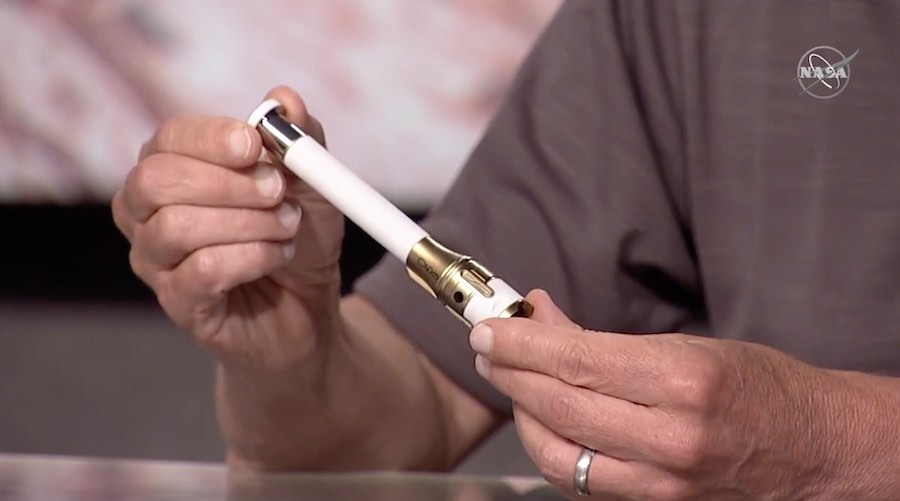
NASA selected seven scientific payloads to ride to Mars on the Perseverance rover in 2014.
Two of the instruments, named PIXL and SHERLOC, are located alongside the coring drill on the robotic arm’s turret. They will scan Martian rocks to determine their chemical composition and search for organic materials, providing key inputs into decisions by ground teams on which rocks to drill.
The Mars 2020 rover also carries the SuperCam instrument, an intricate suite of sensors, including a camera, laser and spectrometers, designed to zap Martian rocks from more than 20 feet (6 meters) away to measure their chemical and mineral make-up, with the ability to identify organic molecules.
Developed by an international team in the United States, France and Spain, the SuperCam instrument is an upgraded version of the ChemCam instrument currently operating on NASA’s Curiosity Mars rover.
The instruments mounted inside the Mars 2020 rover’s main body include MOXIE, which will demonstrate the production of oxygen from carbon dioxide in the atmosphere of Mars, a capability that future astronaut explorers could use on the Red Planet. A Norwegian-developed ground-penetrating radar on the rover named RIMFAX will study the planet’s underground geologic structure, yielding data on subsurface layers and soil strength which could help designers of larger landers designed to carry people to Mars.
The mission also carries a weather station and 23 cameras — the most ever flown on a deep space mission — including the first camera on Mars with a zoom function. That camera system, located on top of a mast Perseverance will raise after landing, is named Mastcam-Z and will record video and 360-degree panoramas.
“We’re carrying about 50 percent more surface payload than Curiosity did, and that was, by far, the most complex thing we’ve ever done up to that point in time,” Wallace said. “We’re taking this a step further.”
The differences between Perseverance and NASA’s predecessor Curiosity rover do not stop at the science payload or the Ingenuity helicopter.
The Perseverance rover also features aluminum wheels with thicker skin and modified treads to avoid damage observed on Curiosity’s wheels on Mars. NASA’s new Mars rover weighs about 278 pounds (126 kilograms) more than Curiosity.
The benefit of another decade of technological advancement since Curiosity’s launch, and the budding fruits of NASA’s partnership with ESA on a Mars Sample Return program, moves scientists closer to addressing the question of whether life took hold elsewhere in the solar system, Bridenstine said.
“We are, in fact, trying to find signatures of life, and of course, we’re interested in finding life itself,” Bridenstine said.
While NASA officials are careful to say Perseverance is not a mission to detect life, its launch and landing on Mars will be a big leap forward in the search.
“There are so many things that are kind of building up here to say that the probability of finding life on another world is going up,” Bridenstine said. “We’re not saying it’s there. I don’t know if it’s there, and nobody else does either. But that’s really what astrobiology is all about, and Mars really gives us the best opportunity, I think, in the short term to make a significant discovery that will forever change how we think of ourselves, and forever change how we think of space exploration in general.”
Assuming Perseverance’s mission is a success, and funding and technical plans remain on track, NASA and ESA could launch missions as soon as 2026 with a European-built Mars rover to retrieve the specimens collected by the Mars 2020 mission. The rover will deliver the material to a U.S.-supplied solid-fueled booster to shoot the samples from Mars into space, a feat never before attempted on another planet.
A separate spacecraft provided by ESA will link up with the samples in orbit around Mars, then head for Earth before releasing a NASA re-entry capsule containing the Martian material to complete the first round-trip interplanetary mission no earlier than 2031.
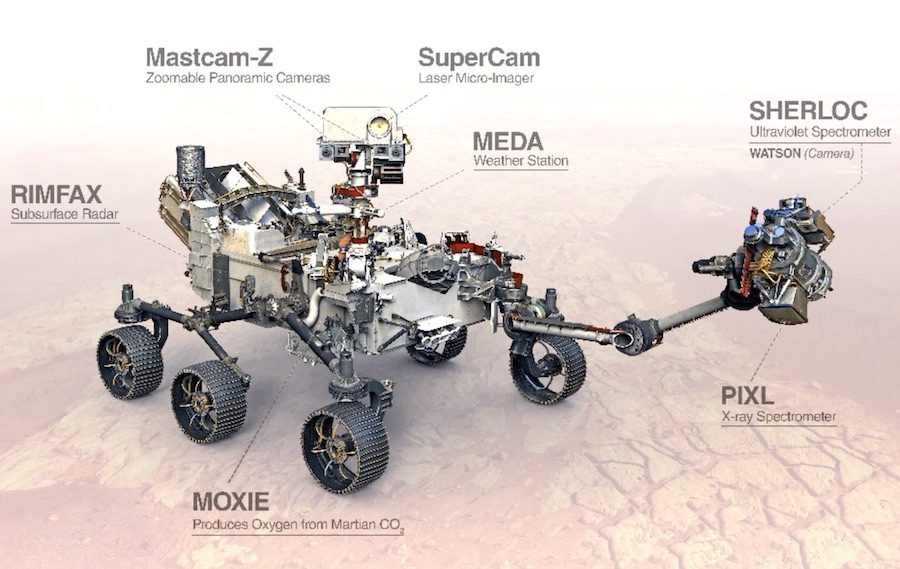
Then scientists will get to work analyzing the samples. They will look for chemical signatures in the core samples that might suggest life once existed on Mars.
Among other objectives, NASA’s two Viking landers carried instruments to search for signs of life on Mars when they landed on the Red Planet in 1976. But the robotic landers did not produce any verifiable confirmation of life, and Mars missions since Viking have followed the trail of water, seeking evidence that the Red Planet once harbored environments that could have supported basic life forms.
After the dual successes of the Viking landers, NASA’s next mission to the Martian surface was Mars Pathfinder, which deployed a small rover just 26 inches (66 centimeters) long named Sojourner in 1997. That mission proved NASA, and more specifically engineers at the Jet Propulsion Laboratory, could build mobile robots to explore the Red Planet.
Next came the larger Spirit and Opportunity rovers, which landed at two different sites on Mars in 2004.
“Spirit and Opportunity together established that Mars truly was habitable, that it had abundant water on the surface in many forms, in the forms of large lakes, small lakes, flowing rivers, even hot springs,” said Jim Watzin, director of NASA’s Mars exploration program. “So with that knowledge in hand and the experience that we gained in operating the Spirit and Opportunity, we went and developed what has been our flagship to date, and that’s the Curiosity rover.”
Curiosity carried a more comprehensive set of instruments to Mars, including a drill to collect pulverized rock samples and deliver the material to a miniaturized laboratory. Curiosity launched in 2011 and landed inside Gale Crater on Mars in August 2012, and found rock layers at the landing site that formed in a lake that dried up billions of years ago.
The rover also discovered organic carbon — a building block of life — inside Martian rocks, and detected that ancient Mars had the right ingredients to support living microbes.
Curiosity is still operating today and slowly climbing higher on Mount Sharp, a 3.4-mile-high (5.5-kilometer) mountain towering above the crater floor.
Amid the series of rover missions, NASA also dispatched two successful stationary landers to Mars.
The Phoenix lander touched down on the northern polar plains of Mars in 2008 and dug into the soil to find water ice just below the surface. NASA’s InSight spacecraft arrived on Mars in 2018 to measure the planet’s seismology and probe its internal structure.
Email the author.
Follow Stephen Clark on Twitter: @StephenClark1.


